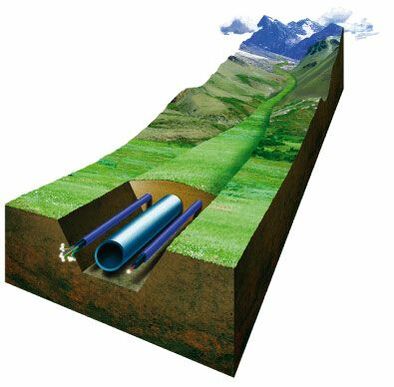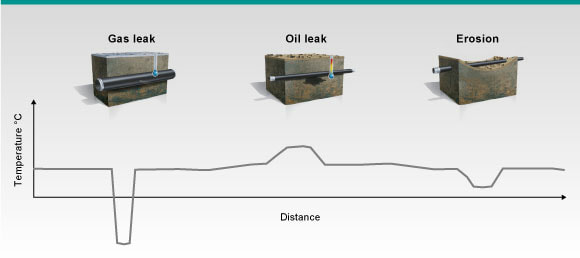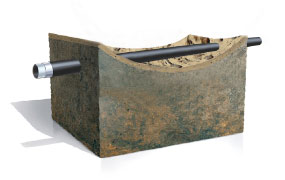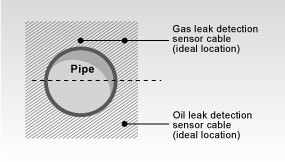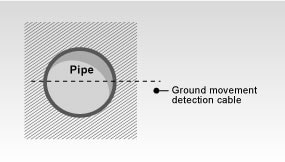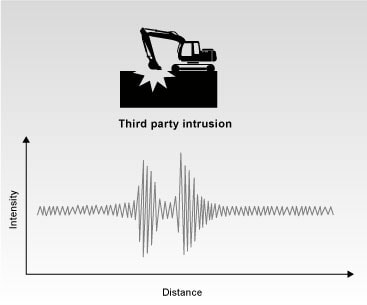HOW CAN OMNISENS LYNX HELP AVOID PIPELINES BECOMING DAMAGED?Omnisens Lynx transforms a fiber optic cable into a continuous, real time monitoring system at minimal extra cost. This technique helps operators detect the earliest stages of threats to the pipeline, giving them time and information to enable an efficient response.
An external fiber optic cable, often included during pipeline installation for communications, is used to detect leaks, ground movement and third party intrusion, helping avoid pipeline damage. |
WHY CHOOSE OMNISENS LYNX?
Using Omnisens Lynx helps detect leaks, ground movement and intrusion at their earliest stages
Omnisens Lynx fiber optic distributed sensing system provides:
|
|
Omnisens proprietary monitoring software ensures that detected events are analyzed so that alerts are communicated and false alarms minimized. Omnisens Lynx system is modular, built around the requirements and risks of each pipeline project.
Each Lynx system offers a range of high performance interrogators:
Leak detection:
Raman and Brillouin Distributed Temperature Sensing (DTS) detect temperature changes from which leaks can be inferred. Ground water movement and erosion can also be thus detected.
Geohazard effect and ground movement detection:
Brillouin Distributed Temperature and Strain Sensing (DTSS) is sensitive to movements of soil along the pipeline way which may, for example, result from a landslide, rock fall or seismic event. The strain induced on the optical fiber sensor installed on the pipeline right of way provides the earliest detection and location of the event.
Intrusion detection:
a dedicated system based on fiber optic distributed Vibration/Acoustic Sensing (DVS/DAS) detects intrusion.
Omnisens is uniquely placed to supply a Lynx pipeline integrity monitoring system to suit each pipeline’s or pipeline integrity management system’s requirement.
Each Lynx system offers a range of high performance interrogators:
Leak detection:
Raman and Brillouin Distributed Temperature Sensing (DTS) detect temperature changes from which leaks can be inferred. Ground water movement and erosion can also be thus detected.
Geohazard effect and ground movement detection:
Brillouin Distributed Temperature and Strain Sensing (DTSS) is sensitive to movements of soil along the pipeline way which may, for example, result from a landslide, rock fall or seismic event. The strain induced on the optical fiber sensor installed on the pipeline right of way provides the earliest detection and location of the event.
Intrusion detection:
a dedicated system based on fiber optic distributed Vibration/Acoustic Sensing (DVS/DAS) detects intrusion.
Omnisens is uniquely placed to supply a Lynx pipeline integrity monitoring system to suit each pipeline’s or pipeline integrity management system’s requirement.
-
What is Omnisens Lynx?
-
Pipeline Leak Detection
-
Geohazard effect Detection
-
Intrusion Detection
-
Deformation Detection
-
Omnisens Service
<
>
THE OMNISENS LYNX SYSTEM FORMS ONE ELEMENT OF THE OPERATOR’S INTEGRATED SECURITY SYSTEM. IT PROVIDES CONTINUOUS, REAL-TIME MONITORING TO DETECT AND LOCATE:
- very small, developing (incipient) leaks
- early signs of landslide, ground movement and the effects of other geohazards
- seasonal changes impacting surrounding soil, (e.g.: flooding, freezing, thawing)
- early signs of soil erosion
- right-of-way (ROW) third party intrusion (authorized and non-authorized)
- position and speed of pipeline smart pigs
The system comprises:
Omnisens high performance distributed temperature sensing (dts)
Based on Brillouin or Raman scattering depending on the project requirements, DTS detects and locates small temperature and or strain changes along the entire length of a pipeline continuously, in real time.
- Omnisens DITEST (Distributed Temperature and Strain Sensing)interrogators are based on Brillouin sensing using single mode optical fibers as the sensor. They measure strain and temperature or both. So DITEST is a DTS which provides effective leak detection (via temperature monitoring) of pipelines, as well as being highly sensitive to ground movement, via strain detection.
- Omnisens Raman DTS interrogators provide temperature monitoring of pipelines using multimode optical fiber as the sensor. For many pipelines, particularly short lengths these are ideal.
Omnisens DIVADetects and analyses vibrations around the pipeline right-of-way enabling accurate and efficient event detection/localization and classification into threat and non-threat events. Activities close to the pipeline (normal or unauthorized) are detected, localized and defined as threat or non-threat depending on the measured vibration characteristics.
|
Monitoring SoftwareProcesses temperature, strain and vibration data. Generates alerts, manages data handling and storage in a proprietary database.
|
Interface and CommunicationThird party system communication via TCP/IP communication or relays.
|
Sensing CableStandard single mode fiber optic telecommunications cable is required for DITEST and DIVA, multimode fiber for Omnisens Raman DTS. This can be existing cable (for leak detection), or Omnisens specified or Omnisens supplied cable.
|
Omnisens map
Omnisens Lynx summary
Performance: Omnisens Lynx combines the measuring performance of Omnisens DITEST (for the earliest detection of leaks and/or ground movement) and Omnisens DIVA (for intrusion detection) with Omnisens Map user Interface to provide a cost effective pipeline integrity monitoring solution.
Omnisens DITEST and DIVA interrogators monitor distances in excess of 40 km. The spatial resolution of DITEST is set during configuration and stays the same along the distance range. High optical budget gives an optical fiber installation margin. Omnisens Raman based DTS is suitable for shorter pipeline lengths.
Sensitivity: Incipient temperature (leak), strain (ground movement) and vibration (intrusion) events can be detected and localized early, giving the operator time to take action.
Communication: Status and detected events can be communicated in real time to a range of third party systems. Omnisens follows Information Security Management guidelines to ensure information integrity, availability and traceability.
Cost effective and flexible: If fiber optic cable is being installed with the pipeline, using some of the fibers to provide leak and intrusion detection is done at minimal additional cost. A fiber optic cable for ground movement detection is more specialized. For leak detection (temperature monitoring) of shorter pipeline lengths Omnisens Raman DTS is available. It requires multimode sensing fiber and does not provide ground movement detection.
Omnisens DITEST and DIVA interrogators monitor distances in excess of 40 km. The spatial resolution of DITEST is set during configuration and stays the same along the distance range. High optical budget gives an optical fiber installation margin. Omnisens Raman based DTS is suitable for shorter pipeline lengths.
Sensitivity: Incipient temperature (leak), strain (ground movement) and vibration (intrusion) events can be detected and localized early, giving the operator time to take action.
Communication: Status and detected events can be communicated in real time to a range of third party systems. Omnisens follows Information Security Management guidelines to ensure information integrity, availability and traceability.
Cost effective and flexible: If fiber optic cable is being installed with the pipeline, using some of the fibers to provide leak and intrusion detection is done at minimal additional cost. A fiber optic cable for ground movement detection is more specialized. For leak detection (temperature monitoring) of shorter pipeline lengths Omnisens Raman DTS is available. It requires multimode sensing fiber and does not provide ground movement detection.
|
Omnisens Lynx monitors all along the monitored pipeline or section. Thanks to its distance range the interrogator can be housed many kilometers from the asset being monitored, if required.
An optical switch provides extra channels enabling the detection of leaks, ground movement and intrusion simultaneously. Alerts can be sent to SCADA via TCP or relays. |
Leaks from a pipeline cause temperature changes in the surrounding soil.
Omnisens Lynx analyses the temperature all along the pipeline route, detecting and locating small leaks to within a few meters. Statistical algorithms process many parameters in order to discriminate leaks from normal seasonal temperature and climate variations.
Omnisens Lynx analyses the temperature all along the pipeline route, detecting and locating small leaks to within a few meters. Statistical algorithms process many parameters in order to discriminate leaks from normal seasonal temperature and climate variations.
Leak detection gas pipelines
Leak detection liquid phase pipelines
Most liquids are warmer than ambient soil temperature so when they escape a temperature event is generated which will be detected by the fiber optic sensor installed nearby.
This temperature (warming) event is detected and located by the Omnisens Lynx system and an alert is annunciated. The operator can then investigate and take action. |
Erosion DetectionErosion of the ground around a pipeline can render it unstable. A change in temperature profile can indicate erosion. In addition (seasonal) water ingress into the pipeline trench causes a temperature change which can be monitored and the position of the event(s) investigated to see the extent of any changes in the ground or soil structure.
|
Sensing fiber selection
|
Telecommunication grade single-mode fiber optic cables are required for leak and intrusion detection.
Omnisens provides:
|
Geohazards can cause damage to the pipeline right-of-way, which in turn threaten the integrity of the pipeline.
To provide highly sensitive, cost effective and robust monitoring to any one or all of these threats, Omnisens Lynx offers a comprehensive threefold solution:
To provide highly sensitive, cost effective and robust monitoring to any one or all of these threats, Omnisens Lynx offers a comprehensive threefold solution:
- Distributed temperature detection
- Distributed strain detection
- Distributed vibration detection
|
A change in temperature may indicate other events which could affect the pipeline. Erosion of the soil around the pipeline can cause a temperature change, as can water intrusion from flooding or the change of soil condition between frozen and thawed. Omnisens Lynx detects these temperature changes and an alert showing their location will be generated. The operator can investigate that part of the pipeline and mitigate against further damage.
To cater for the different challenges of each pipeline route, Omnisens Lynx offers the flexibility to monitor the various geohazard threats in combination or separately. This choice means a comprehensive and cost effective solution integrity monitoring solution can be designed, whatever the threats may be. |
Fiber optic cable selection
|
The single mode fiber optic sensor is in a cable which combines tensile strength with maximum strain sensitivity for ground movement detection.
Omnisens can provide: guidance on fiber optic sensing cable selection and installation procedures, with or without installation service fiber optic sensing cable options for various harsh environments or installation in conduits |
Construction unauthorized access and digging, for example, pose an immediate and real threat to all concerned. Omnisens DIVA detects, locates and classifies vibrations caused by third party intrusion in real-time along the entire monitored length of the pipeline.
Disturbances create microscopic stresses or vibrations in the soil to which standard telecoms cable (optical fiber sensing cable) is sensitive. Interpretation using complex algorithms classifies these to determine whether the signal is an abnormal event or a normal environmental/ambient condition.
Sensitive enough to detect an intrusion before it becomes a threat, Omnisens DIVA can detect, for example, the arrival of a digger before it starts to dig. When a security event is detected, an alert is triggered and displayed on Omnisens Map (or other GIS) and communicated to the pipeline’s SCADA or other third party system.
Disturbances create microscopic stresses or vibrations in the soil to which standard telecoms cable (optical fiber sensing cable) is sensitive. Interpretation using complex algorithms classifies these to determine whether the signal is an abnormal event or a normal environmental/ambient condition.
Sensitive enough to detect an intrusion before it becomes a threat, Omnisens DIVA can detect, for example, the arrival of a digger before it starts to dig. When a security event is detected, an alert is triggered and displayed on Omnisens Map (or other GIS) and communicated to the pipeline’s SCADA or other third party system.
PIG TRACKING
Vibrations created during pigging propagate in the surrounding soil. Using a fiber optic cable laid nearby the pigs can be tracked in real time using the Omnisens DIVA. For a pig tracking campaigns a portable Omnisens DIVA is available.
FIBER OPTIC CABLE SELECTION
Intrusion detection requires telecommunication grade single mode fiber optic cables. An existing optical fiber cable can often be used.
Omnisens can provide:
Vibrations created during pigging propagate in the surrounding soil. Using a fiber optic cable laid nearby the pigs can be tracked in real time using the Omnisens DIVA. For a pig tracking campaigns a portable Omnisens DIVA is available.
FIBER OPTIC CABLE SELECTION
Intrusion detection requires telecommunication grade single mode fiber optic cables. An existing optical fiber cable can often be used.
Omnisens can provide:
- guidance on fiber optic sensing cable selection or existing fiber optic cable suitability and installation procedures, with or without installation service
- fiber optic sensing cable options for various harsh environments or installation in conduits
To detect pipeline deformation or buckling, the optical fiber strain sensor is attached to the pipeline itself, so that any movement is coupled to the fibers. The extension and compression of the fibers during movement is detected and will signal an alert.
Pipe deformation and buckling commonly results from geohazard activity. Sometimes the pipe requires immediate replacement. Sometimes it is monitored (instrumented as shown) and watched further movement. Installation of the sensing fibers is done either pre-installation where a known risk exists, or on excavation of the affected sections.
FIBER OPTIC CABLE SELECTION
Pipeline deformation monitoring requires strain detecting fiber optic cables. For temperature compensation an existing optical fiber cable can often be used.
Omnisens can provide:
Pipeline deformation monitoring requires strain detecting fiber optic cables. For temperature compensation an existing optical fiber cable can often be used.
Omnisens can provide:
- guidance on fiber optic sensing cable selection or existing fiber optic cable suitability and installation procedures, with or without installation service
- fiber optic sensing cable options for various harsh environments
|
PRE-PURCHASE
A training course on Omnisens Lynx including ‘hands-on’ use of the interrogator is available to understand the system and decide how best to configure it for a particular project. It is available in Morges, Switzerland or at the customer’s site. APPLICATION ENGINEERING Selection and testing of fiber optic sensor is critical to the system function. Whether Omnisens is supplying the sensing cable or not, it is important that they are involved in the cable choice and installation to ensure the system performs to the project requirements.
|
COMMISSIONING AND INSTALLATION
SERVICE CONTRACTS A range of services is available to ensure continuous availability of the monitoring system, including post commissioning support. |


